Aching Backs in the Information Age
by Professor Evergreen Keefer
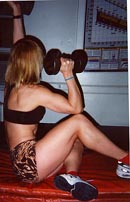
Coles at NYU:Step Aerobics at noon,
Ab Lab at 5:00 p.m. on Saturday. Thursday: 12:30: Knock Out/Step Out. 1:30:
Abs and Stretch
West Side Y:Arthritic Swim and Aquacise on Friday
from 12:30 to 2:30. Sunday marathon of step aerobics (with funk and kickbox),
body sculpting, ab lab and stretch from 4:00 to 7:00 p.m. Monday night: Aerobox
and Kick: 7:30 p.m. Massage, neuromuscular reeducation, and personal training
by appointment.
(Some of the following images have been passed down through generations of kinesiologists
such as Mabel Todd, Lulu Sweigard, Andre Bernard, etc.)
You've just upgraded your computer and your modem, installed the
latest software and our now ready to live your life in cyberspace. It's so easy
to write and work and play without the hassle of commuting. With a click of
the finger you can talk to colleagues at the Coconut Cafe in Hawaii, browse
through a European classical library or check out the latest political and economic
news. But you are now spending 12 hours a day sitting at your computer and your
back aches! Gone are those strong muscles you had playing sports in college.
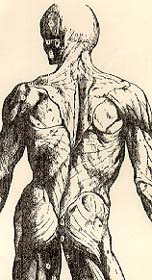
The most important and most difficult way to protect your back
is to sit properly. Although many people think that good posture consists of
a straight back, a healthy spine has a forward curve in the 7 neck (cervical)
vertebrae; a backward curve in the 12 upper back (thoracic); forward for the
5 lower (lumbar); and back in the fused pelvic (sacral) and tailbone (coccyx)
areas.
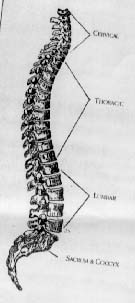
Nevertheless, these curves are balanced on a plumb line as if a string were pulling the top of your head to the ceiling.
Since most of our conscious perception is with the front of our bodies, (one of the causes of round
shoulders, forward heads, and low back strain), imagine that you have a face, torso and legs on the
back of your body. Allow warmth, energy and expression to travel out the back of your body. Feel
the three dimensionality of the body, expanding in all directions.
As you read the screen in front of you (at eye level, never below), pretend
you have eyes in the back of your head pulling your skull back on top of your
shoulders. Allow the muscles at the base of the skull to soften and melt. Then
imagine you are wearing a soft, thick cashmere turtleneck which comes from the
hairline around the neck under the chin. The neck feels soft, long, warm and
protected.  Imagine the face as that of a wax figurine.
Light a candle under the jaw and allow the facial features to drip down like
hot wax. The mouth opens slightly, the teeth part, the tongue lies heavy and
the wax drips from the chin to the chest. Place your fingers over the hyoid
bone under the chin and feel it glide gently back and forth. Feel the wax drip
from the ear lobes to the top of the shoulders. As the head and neck relax,
imagine this area widening like a balloon filled with helium. The space increases
between the ears and the balloon floats away from the rest of the spine. The
spine lengthens and all tension melts from the head and neck. Close your eyes,
see out the back of your head and gently turn your head to the left and right.
Then bring your chin to your chest and look up to the ceiling, expanding the
chest without pinching the neck. Bring your right ear to your right shoulder,
put your right hand on your left ear and lift your left shoulder up and down
to stretch the left trapezius muscles. Then do the same with the right trapezius
by bring your left ear to your left shoulder and placing your left hand on your
right ear as your right shoulder comes up and down. If you have severe neck
arthritis, be careful of this last exercise.
Imagine the face as that of a wax figurine.
Light a candle under the jaw and allow the facial features to drip down like
hot wax. The mouth opens slightly, the teeth part, the tongue lies heavy and
the wax drips from the chin to the chest. Place your fingers over the hyoid
bone under the chin and feel it glide gently back and forth. Feel the wax drip
from the ear lobes to the top of the shoulders. As the head and neck relax,
imagine this area widening like a balloon filled with helium. The space increases
between the ears and the balloon floats away from the rest of the spine. The
spine lengthens and all tension melts from the head and neck. Close your eyes,
see out the back of your head and gently turn your head to the left and right.
Then bring your chin to your chest and look up to the ceiling, expanding the
chest without pinching the neck. Bring your right ear to your right shoulder,
put your right hand on your left ear and lift your left shoulder up and down
to stretch the left trapezius muscles. Then do the same with the right trapezius
by bring your left ear to your left shoulder and placing your left hand on your
right ear as your right shoulder comes up and down. If you have severe neck
arthritis, be careful of this last exercise.
Take your hands off the keyboard, open and close your fingers, circle your wrists, turn your arms
in and out. Elevate and depress your shoulders. Focus on your breathing and let your rib cage
expand and contract freely like a fire bellows. Imagine the sternum (breastplate) smeared with hot
butter from a breadknife. The butter drips sideways, allowing the top of the chest to open. Imagine
you are wearing a sparkling diamond necklace that catches the light around the base of your neck.
Keep your head up and back with the helium balloon and eyes in the back of the head. Feel warm
water moving from the armpits across the pectoral muscles up over the shoulders and down the back
under the shoulder blades in a continuous circle up the front of the chest down the spine. The
water drips under the shoudler blades, separating the shoulder girdle from the spine. Then imagine
the entire shoulder girdle--shoulder blades, collar bones, shoulders and arms;; as a soft, velvet cape
draped over the rib cage and fastened with a pin at the sternum. The velvet drapes down to the
back of the pelvis so that the arms feel connected to the low back. If you can, take a towel or shirt
and do these stretches. 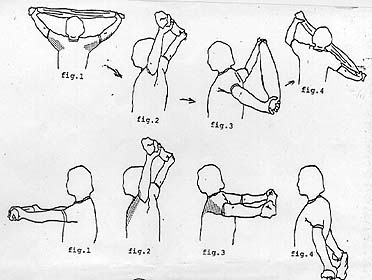
Now check your sitting posture and make sure you are sitting on the tuberosities of the ischia
and not your poor, fragile tail bone. Uncross your legs and put your feet flat on the floor, relaxing
your toes. If possible, use a lumbar roll to maintain the lordotic curve of the lower back and keep
you on your "sit bones." 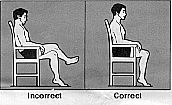 Place your hands on your abdomen. As the muscles of the pelvis relax
and the spine lengthens, imagine a wide round balloon slowly filling with air as you inhale. The air
gently moves into the back and sides as well as the front of the pelvis. As you exhale, the diaphragm
relaxes and the abdominal muscles contract as the balloon deflates. Exhale completely, zipping
an imaginary zipper from the pubic bone to the bottom of the sternum. As you exhale, imagine
a magnet pulling the navel into the middle of the low back but do not try to flatten your back.
Place your hands on your abdomen. As the muscles of the pelvis relax
and the spine lengthens, imagine a wide round balloon slowly filling with air as you inhale. The air
gently moves into the back and sides as well as the front of the pelvis. As you exhale, the diaphragm
relaxes and the abdominal muscles contract as the balloon deflates. Exhale completely, zipping
an imaginary zipper from the pubic bone to the bottom of the sternum. As you exhale, imagine
a magnet pulling the navel into the middle of the low back but do not try to flatten your back.
Push your chair away from the desk and bend over, stretching your back. Relax your head and
neck and let your arms dangle like seaweed. Roll up slowly as you exhale, contracting your abdomen.
Wiggle back and forth on your haunches to make sure you are on your "sit bones" and imagine
them growing roots into the chair. Straighten one leg, tightening your quadriceps muscles and
stretching your hamstrings. Flex and point your foot. Do the same with the other leg and foot.
Feel the spine as a curtain rod being lengthened in the central axis of the
body. As the body lengthens and relaxes, pretend the spine is a child's slinky
toy. the little rings of metal are like the vertebral bodies. As they are stretched
apart, imagine 26 empty spaces in your spine getting wider. Grow a furry tail
out of your tailbone which drags along the floor as the helium balloon lifts
the top of your head to the ceiling.
As soon as you can get away from your desk, stretch your hip flexors (iliopsoas
muscles), preferably by letting the straight leg dangle off a table while lying
on your back with your buttocks off the edge with both hands pulling the other
knee into the chest. 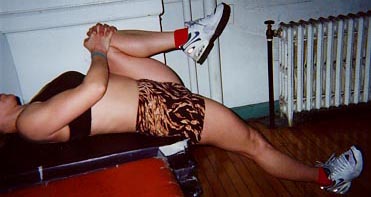
Remember to watch your alignment when you sleep. 8 hours of tortured
twisting in bed can undo hours of good posture and exercises. You are finally
in your bedroom or at the gym and ready for
Dr. Keefer's Back Care and Conditioning Program: After
warming up your neck and shoulders, spinal flexion, extension, lateral flextion
and rotation, begin a series of abdominal strengthening exercises. There are
at least 20 variations that culminate in advanced full sit-ups and leg raises
to test abdominal strength against the hip flexors. However, the average person
rarely progresses past half sit-ups with the knees bent. Exhale and hollow the
abdomen as you contract the abdomen, lifting your head and shoulders off the
floor. Use the transversus abdominis to flatten the abdomen as you exhale, an
action that will later help prevent hernias.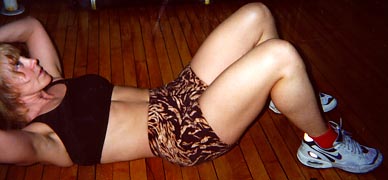
Don't forget the oblique muscles, as you include repetitions bringing the
shoulder towards the opposite hip. Advanced students can do side-lying sit-ups
for the quadratus lumborum and the obliques, better known affectionately as
love handles. These side exercises requires strong isometric contractions of
the latissimus dorsi and transversus abdominis muscles to stabilize the torso
and protect the back.All ab routines should include spinal extension and/or
hyperextension exercises lying on your stomach. Lift your head, neck, shoulders
and chest off the floor as you contract your spinal extensors. Arm positions
may vary with hands on the head, the neck, the shoulders or laced together behind
the buttocks. If you have severe arthritis, posterior osteophytes, spondylolisthesis,
stress fractures etc. you should substitute spinal extension for hyperextension
and perform these exercises lying over a bench with your arms, legs and/or head
dangling off towards the floor. Lift the extremities to bring the entire body
to a horizontal position parallel to the floor, not arched backwards. This does
require a bench, a step or huge ball upon which the torso can lie.
Dr. Keefer's Back/Ab program is always accompanied by stretches of the hamstrings,
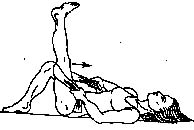 iliopsoas (see psoas stretch), piriformis
iliopsoas (see psoas stretch), piriformis 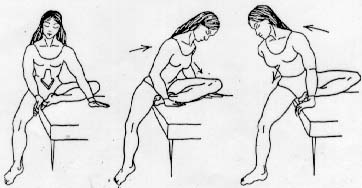
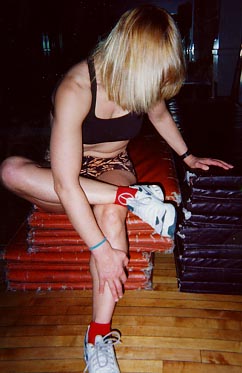 and strengthening of the back extensors.
and strengthening of the back extensors.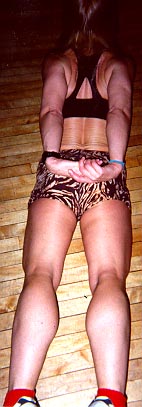 Never
just do sit-ups without strengthening your back muscles.
Never
just do sit-ups without strengthening your back muscles.
Advanced Conditioning: No matter how complex your workouts become,
try to include exercises and routines that satisfy requirements for cardiovascular
training, strength training, flexibility and neurologic conditioning. For example,
Prof. Keefer's cardiovascular training includes jogging, step aerobics, skiing,
biking and hiking; her strength training includes cybex and kaiser machines,
free weights and body lever disadvantage for both repetition/endurance work
and maximal power lifting, including negatives; her neurologic training (bodymind)
consists of aquatics, yoga and ballet for balance, posture, coordination, dynamic
and rhythm changes (reflexes), focus and meditation. Often people will just
run or do yoga or weight train, neglecting the other systems of the body. Remember
a weight-training program should include all muscles, agonist and antagonists,
not just ones you happen to like. 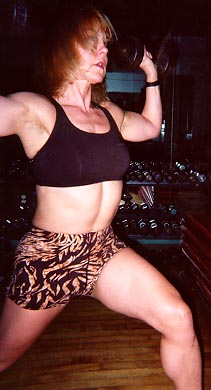


Don't spend all your time in the physical gym. Brain gyms are just as important.
Life is a balance between body and mind.
Return to home page



 Imagine the face as that of a wax figurine.
Light a candle under the jaw and allow the facial features to drip down like
hot wax. The mouth opens slightly, the teeth part, the tongue lies heavy and
the wax drips from the chin to the chest. Place your fingers over the hyoid
bone under the chin and feel it glide gently back and forth. Feel the wax drip
from the ear lobes to the top of the shoulders. As the head and neck relax,
imagine this area widening like a balloon filled with helium. The space increases
between the ears and the balloon floats away from the rest of the spine. The
spine lengthens and all tension melts from the head and neck. Close your eyes,
see out the back of your head and gently turn your head to the left and right.
Then bring your chin to your chest and look up to the ceiling, expanding the
chest without pinching the neck. Bring your right ear to your right shoulder,
put your right hand on your left ear and lift your left shoulder up and down
to stretch the left trapezius muscles. Then do the same with the right trapezius
by bring your left ear to your left shoulder and placing your left hand on your
right ear as your right shoulder comes up and down. If you have severe neck
arthritis, be careful of this last exercise.
Imagine the face as that of a wax figurine.
Light a candle under the jaw and allow the facial features to drip down like
hot wax. The mouth opens slightly, the teeth part, the tongue lies heavy and
the wax drips from the chin to the chest. Place your fingers over the hyoid
bone under the chin and feel it glide gently back and forth. Feel the wax drip
from the ear lobes to the top of the shoulders. As the head and neck relax,
imagine this area widening like a balloon filled with helium. The space increases
between the ears and the balloon floats away from the rest of the spine. The
spine lengthens and all tension melts from the head and neck. Close your eyes,
see out the back of your head and gently turn your head to the left and right.
Then bring your chin to your chest and look up to the ceiling, expanding the
chest without pinching the neck. Bring your right ear to your right shoulder,
put your right hand on your left ear and lift your left shoulder up and down
to stretch the left trapezius muscles. Then do the same with the right trapezius
by bring your left ear to your left shoulder and placing your left hand on your
right ear as your right shoulder comes up and down. If you have severe neck
arthritis, be careful of this last exercise. 
 Place your hands on your abdomen. As the muscles of the pelvis relax
and the spine lengthens, imagine a wide round balloon slowly filling with air as you inhale. The air
gently moves into the back and sides as well as the front of the pelvis. As you exhale, the diaphragm
relaxes and the abdominal muscles contract as the balloon deflates. Exhale completely, zipping
an imaginary zipper from the pubic bone to the bottom of the sternum. As you exhale, imagine
a magnet pulling the navel into the middle of the low back but do not try to flatten your back.
Place your hands on your abdomen. As the muscles of the pelvis relax
and the spine lengthens, imagine a wide round balloon slowly filling with air as you inhale. The air
gently moves into the back and sides as well as the front of the pelvis. As you exhale, the diaphragm
relaxes and the abdominal muscles contract as the balloon deflates. Exhale completely, zipping
an imaginary zipper from the pubic bone to the bottom of the sternum. As you exhale, imagine
a magnet pulling the navel into the middle of the low back but do not try to flatten your back. 

 iliopsoas (see psoas stretch), piriformis
iliopsoas (see psoas stretch), piriformis 
 and strengthening of the back extensors.
and strengthening of the back extensors. Never
just do sit-ups without strengthening your back muscles.
Never
just do sit-ups without strengthening your back muscles.


